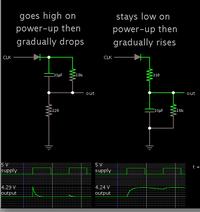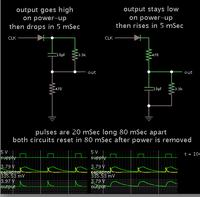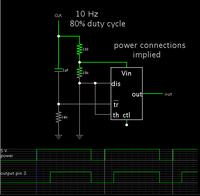browner87
Newbie level 4

I'm building a circuit and this is the basics of it:
After a brief delay after power-up, a latch goes from low to high and stays high until power-down.
On a more technical level:
A 555 timer starts at power up. I feed its output into the NOT-R of a NOT-SR latch. I'll attach the circuit below.
Now, if I build just the 555 timer part and hook an LED (and resistor) to its output, it appears the output is immediately high after power-up, and then goes low after ~3 seconds as expected.
And if I build just the latch part, Q is high on power-up as expected (and will go low if I ground NOT-R).
The problem is, if I connect the output of the 555 timer to the NOT-R of the latch (the circled wire), Q is low and NOT-Q is high at power up. Unfortunately I don't have an oscilloscope lying around to check, but logic says to me that the output of the 555 timer is low for a couple nano or microseconds at startup which is enough to toggle the latch too soon.
Does anyone know how I can make the latch "wait" a couple milliseconds to let the timer power up? I'm sure a well-placed capacitor would fix it in a heartbeat, but I can't decide exactly where to put it to get the desired result.
After a brief delay after power-up, a latch goes from low to high and stays high until power-down.
On a more technical level:
A 555 timer starts at power up. I feed its output into the NOT-R of a NOT-SR latch. I'll attach the circuit below.
Now, if I build just the 555 timer part and hook an LED (and resistor) to its output, it appears the output is immediately high after power-up, and then goes low after ~3 seconds as expected.
And if I build just the latch part, Q is high on power-up as expected (and will go low if I ground NOT-R).
The problem is, if I connect the output of the 555 timer to the NOT-R of the latch (the circled wire), Q is low and NOT-Q is high at power up. Unfortunately I don't have an oscilloscope lying around to check, but logic says to me that the output of the 555 timer is low for a couple nano or microseconds at startup which is enough to toggle the latch too soon.
Does anyone know how I can make the latch "wait" a couple milliseconds to let the timer power up? I'm sure a well-placed capacitor would fix it in a heartbeat, but I can't decide exactly where to put it to get the desired result.




